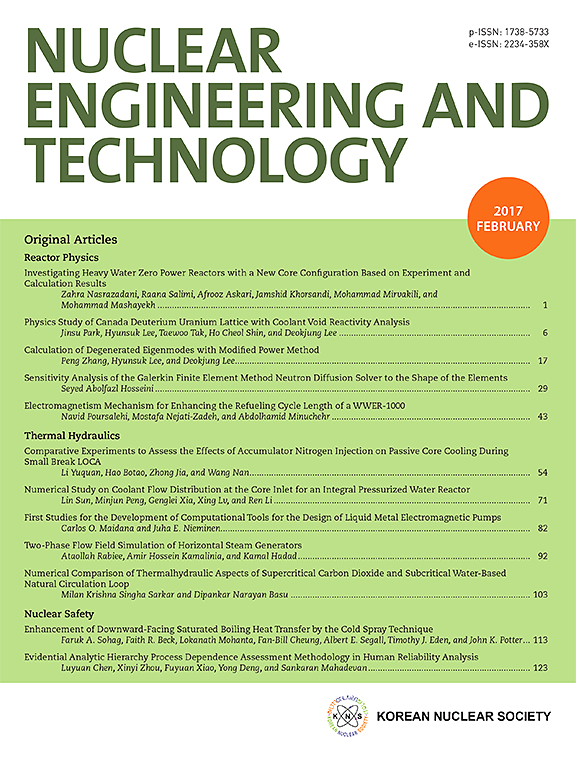Floor response characteristics of NPP auxiliary building subjected to bi-directional ground motions
IF 2.6
3区 工程技术
Q1 NUCLEAR SCIENCE & TECHNOLOGY
引用次数: 0
Abstract
The objective of this study is to investigate the seismic floor response characteristics at critical locations of the auxiliary building (AB) of a nuclear power plant. AB is so irregular that floor responses at different locations are expected to be different even at the same floor. Time history analyses are performed for a finite element model of AB for various bi-directional ground motions. It is observed that floor response spectra at 12 distinct locations are significantly different. The bi-directional effect is observed to be 24 %–42 % higher when compared to uni-directional cases. The response trajectory due to bi-directional motions shows the major direction of response are variable and solely depends on the ground motion properties suggesting the current analysis techniques being viable for over/under estimation of floor responses. The critical angle of incidence for AB is found to be 105°. Hence, this study also suggests virtually dividing a floor into several groups based on their seismic response characteristics for an efficient evaluation of the seismic performance of large structures like AB.
核电站辅助建筑在双向地面运动下的楼层响应特性
本研究的目的是探讨核电厂辅助建筑关键位置的地震反应特征。AB是如此不规则,以至于即使在同一楼层,不同位置的楼层响应也会有所不同。本文对各种双向地震动的AB有限元模型进行了时程分析。观察到12个不同位置的底板响应谱有显著差异。与单向病例相比,观察到双向效果高出24% - 42%。双向运动引起的响应轨迹表明,响应的主要方向是可变的,并且仅取决于地面运动特性,这表明当前的分析技术对于地板响应的高估/低估是可行的。AB的临界入射角为105°。因此,本研究还建议根据其地震反应特征将楼板划分为几组,以便有效地评估像AB这样的大型结构的抗震性能。
本文章由计算机程序翻译,如有差异,请以英文原文为准。
求助全文
约1分钟内获得全文
求助全文
来源期刊

Nuclear Engineering and Technology
工程技术-核科学技术
CiteScore
4.80
自引率
7.40%
发文量
431
审稿时长
3.5 months
期刊介绍:
Nuclear Engineering and Technology (NET), an international journal of the Korean Nuclear Society (KNS), publishes peer-reviewed papers on original research, ideas and developments in all areas of the field of nuclear science and technology. NET bimonthly publishes original articles, reviews, and technical notes. The journal is listed in the Science Citation Index Expanded (SCIE) of Thomson Reuters.
NET covers all fields for peaceful utilization of nuclear energy and radiation as follows:
1) Reactor Physics
2) Thermal Hydraulics
3) Nuclear Safety
4) Nuclear I&C
5) Nuclear Physics, Fusion, and Laser Technology
6) Nuclear Fuel Cycle and Radioactive Waste Management
7) Nuclear Fuel and Reactor Materials
8) Radiation Application
9) Radiation Protection
10) Nuclear Structural Analysis and Plant Management & Maintenance
11) Nuclear Policy, Economics, and Human Resource Development
 求助内容:
求助内容: 应助结果提醒方式:
应助结果提醒方式:


